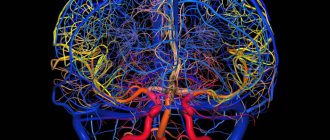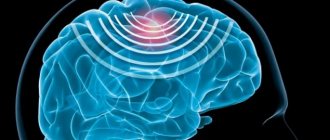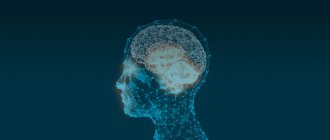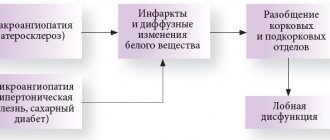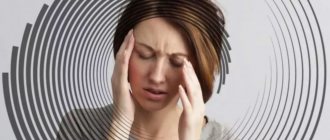Chronic cerebrovascular accidents
I is a form of cerebrovascular insufficiency of the blood supply to the brain, which is a serious problem in modern medicine. These forms include the initial manifestations of a decrease in normal blood supply to the brain, which are often not given due importance and proper measures are not taken, and discirculatory encephalopathy, which can lead to serious consequences for the body. Physiologically, the essence of such conditions manifests itself gradually, often slowly progressing, insufficient blood supply to the brain. The result is the appearance, after a certain period of time, of multiple small foci of brain tissue with dead areas, which leads to disruption of important functions of the brain and the entire body as a whole. Chronic cerebrovascular accident is the main risk factor for stroke, when acute disruption of the blood supply to the brain rapidly develops. In addition, this is the reason for the gradual development of mental disorders and neurological disorders. Timely diagnosis and implementation of adequate therapeutic measures is a key area that relieves patients from the consequences of the development of the disease.
Types of cerebrovascular disorders
It is customary to distinguish the following categories of cerebrovascular disorders:
- strokes - acute form, lasting no more than 24 hours;
- chronic form caused by atherosclerosis, discircular encephalopathy, persistent arterial hypertension.
The disease has three stages:
- the first - with vague symptoms;
- the second - in which the symptoms intensify;
- the third - in which irreversible consequences occur.
Diagnosis of cerebrovascular accident, the symptoms of which are very diverse, requires a highly qualified doctor.
Diagnostic program
History taking
The first specialist you should contact is a therapist. After collecting an anamnesis, the doctor makes a preliminary diagnosis or refers to specialized doctors: a neurologist, neurosurgeon, psychiatrist. When going to an appointment, you need to prepare answers to the following questions in advance:
- Under what circumstances did the syndrome begin?
- How long has this been going on?
- How often do episodes occur and how long do they last?
- Have there been any fainting spells?
- Are there any triggers that provoke an attack (turning the head, torso, sudden change in body position, flashing environmental objects, crowded places, etc.).
- Does hearing decrease at this time and tinnitus appears?
- What accompanying symptoms are observed (nausea, headaches, weakness in arms or legs, speech disorders).
As soon as the doctor understands whether the patient is suffering from a true or non-systemic syndrome, a narrow diagnosis will be prescribed.
Patient examination
During the examination, coordination tests and visual assessment of nystagmus (eye movements) are used. The patient is asked to stand in Romberg's position - vertically with feet tightly together, arms extended forward and eyes closed. If it is difficult to maintain this position, damage to the central nervous system is likely.
To determine the nature of nystagmus, Frenzel glasses are used. They do not allow you to focus your gaze on a specific object. This makes it easier for the doctor to find out whether there is involuntary eye movement and how severe it is. Horizontal rotational movement of the eyeballs indicates peripheral damage to the vestibular system. If the patient focuses on one object, the rotations stop. With a central lesion, the nystagmus is vertical-rotational or unilateral, and does not stop when the gaze is fixed.
The walk-in-place test with eyes closed shows in which direction a person deviates when coordination is incorrect. The affected area of the SMA is located on the same side. With central dysfunction, the deviation occurs in different directions, sometimes the test ends with a fall with a turn towards pathology in the cerebellum.
Be sure to do an orthostatic test: measure the pressure while lying down, then immediately after getting up and a few minutes after that. If the readings have decreased by 20 mmHg, there is reason to diagnose presyncope due to orthostatic hypertension.
Instrumental methods
It is not enough to determine the diagnosis; you need to identify the causes of the syndrome in order to eliminate them. If the patient has been diagnosed in the past with diseases associated with impaired cerebral blood supply, vascular anomalies or neoplasms, an MRI of the brain is performed. This technology is considered the most effective in studying the central nervous system and its membranes. As an examination after a stroke, CT scan of the brain gives the best results. For special indications, contrast is added to study the circulatory network. It enhances the clarity of images, helps assess the speed of blood flow, and find areas with reduced blood circulation.
Since malignant tumors are enveloped in a developed network of vessels, they are clearly visible on an MRI of the head with contrast. The staining solution accumulates in neoplasms faster than in healthy tissues, so even small foci of cancer are visible on scans. For the same reason, an MRI of the pituitary gland is prescribed, since the most common disease of this gland is the growth of tumors.
As a result of MRI studies and CT scans with contrast, the following causes of unsteadiness are revealed:
- cerebral infarction;
- multiple sclerosis;
- congenital anomalies of the cerebellum;
- hemorrhages;
- trunk tumors;
- infections and fibrosis after inflammation.
MRI of the pituitary gland is important to carry out in case of background hormonal disorders accompanying paroxysm. Ultrasound examination is prescribed to assess the patency and integrity of the arteries of the neck. Indications for scanning are:
- high blood pressure;
- predisposition to hereditary heart diseases;
- obesity;
- diabetic syndrome.
If signs point to a cardiogenic source of dizziness, it makes sense to conduct an ECG, Holter monitoring and echocardiography. If these methods are ineffective, additional information is obtained from the results of cardiac MRI or CT coronary angiography with contrast.
Symptoms of cerebrovascular accident
Cerebral circulation disorders, the symptoms of which can be easily confused with manifestations of other diseases, are a serious reason to consult a doctor. Cerebrovascular insufficiency manifests itself:
- dizziness;
- a feeling of instability when walking and changing body position;
- feeling of heaviness in the head;
- irritability;
- increased fatigue;
- change in character (tearfulness, touchiness, etc.);
- insomnia;
- lethargy and inability to concentrate;
- decreased concentration;
- headache;
- noise in the head;
- weather sensitivity;
- memory impairment;
- decreased intelligence;
- surges in blood pressure, etc.
Causes
Systemic dizziness
The source of true paroxysm is the vestibular apparatus (VBA). It is not limited to a single area, it is a whole system that covers the labyrinth of the inner ear, nerve canals, brain stem, cerebellum, pituitary gland, and central nervous system cortex. The connections between these sections and the spinal cord ensure correct orientation in space. Any changes in the vestibular system at the level of the inner ear or brain lead to imbalances.
Unsteadiness due to VBA disorder occurs under the influence of:
- mechanical damage to the inner ear;
- Meniere's disease;
- inflammation of the nerve passing through the vestibular analyzer (neuronitis);
- peripheral fistula;
- labyrinthitis;
- tumor neuroma;
- irritation of the cochlear nerve.
The central section of the analyzer is located in the brain, so its pathologies also affect the vestibular system. These can be short-term circulatory disorders, ischemic strokes, migraines, hemorrhages in the cerebellum, multiple sclerosis, tumors of the trunk, pituitary gland, etc.
Unsystematic dizziness
Paroxysm of the false type is caused by reasons not related to the vestibular system. It could be:
- a sharp decrease in blood pressure when changing orientation in space (for example, getting out of bed);
- heart pathologies that do not allow oxygen to be supplied to the brain;
- depression;
- acute/chronic anemia;
- surges in blood sugar levels;
- long-term medication use.
Chronic vertigo is common among older people. Persistent diseases and age-related changes damage the connections that are responsible for balance. At a young age, the cause may be smoking, anxiety, heart failure, alcohol consumption, antibiotics, pre-stroke or pre-heart attack condition. Neurological diseases and certain environmental factors can aggravate symptoms. Dizziness is more pronounced if objects or a crowd of people are moving nearby. In an open space, where there is no visual “fulcrum”, paroxysm can also occur.
Emotionality can also cause instability syndrome: sudden excitement, a surge of joy or fear, constant anxiety lead to fogginess of consciousness up to its loss.
Causes of the disease
There are many reasons for the development of the disease. The main ones include:
- age after 50 years;
- hereditary factor;
- traumatic brain injuries;
- excess body weight;
- sedentary lifestyle;
- suffered stress;
- emotional lability;
- smoking and drinking alcohol;
- arterial hypertension (the most common cause).
In elderly patients, the disease leads to:
- to atrial fibrillation;
- to blood diseases;
- to chronic thrombophlebitis;
- to heart muscle defects.
CEREBRAL CIRCULATION INSUFFICIENCY OF VASCULAR GENESIS
Preferanskaya Nina Germanovna Associate Professor, Department of Pharmacology, Educational Department, Institute of Pharmacy and Translational Medicine, Multidisciplinary Center for Clinical and Medical Research, International School “Medicine of the Future”, First Moscow State Medical University. THEM. Sechenov (Sechenov University), Ph.D.
Divaza (tablet for resorption No. 100) is an innovative combination drug containing affinity-purified antibodies to the brain-specific protein S-100 and affinity-purified antibodies to endothelial NO synthase. Antibodies to the brain-specific protein S-100 have antioxidant, antihypoxic, neuroprotective, and anxiolytic effects. The combined use of the components of the drug is accompanied by an increase in the neuroprotective activity of antibodies to the S-100 protein, an increase in the vegetative-stabilizing effect, normalization of the vegetative status, a synergistic effect of both components on neuronal plasticity and, as a result, an increase in the brain’s resistance to toxic influences.
The use of the drug improves integrative activity and restores interhemispheric connections of the brain, helps eliminate cognitive impairment, stimulates reparative processes and accelerates the restoration of central nervous system functions, increases mental performance, restores learning and memory processes, normalizes somatovegetative manifestations, and increases cerebral blood flow. The drug does not have a sedative or muscle relaxant effect, and does not cause addiction or addiction.
Divaza is used to restore integrative brain activity in a wide range of organic disorders of the central nervous system caused by neurodegenerative, cerebrovascular diseases, neuroinfections, and traumatic brain injury. Used as part of complex therapy. Individual hypersensitivity reactions to the components of the drug are possible.
1 tablet of the drug contains affinity-purified antibodies to the brain-specific protein S-100 - 0.006 g and affinity-purified antibodies to endothelial NO synthase - 0.006 g.
Instenon is a combination drug containing etamivan, hexobendine and etophylline . The neuroprotective effect of the drug is based on mutual potentiation of effects. The drug selectively stimulates brain metabolism, stabilizes cerebral and systemic circulation, slows down the death of brain neuron cells, moderately dilates coronary and cerebral vessels, increases the utilization of glucose and oxygen by brain cells. When using the drug, performance increases, fatigue, headaches decrease, mood and general tone improve.
The drug is prescribed to patients with acute and chronic forms of vascular pathology of the brain, consequences of a stroke, 2 ml IM or IV, after dissolving it in 200 ml of 5% glucose, 1-2 times a day.
Use 1-2 tablets orally. 3 times a day, without chewing, if necessary, increase the dose to 5 tablets.
Available: table, cover. obol. (50 mg etamivan + 20 mg hexobendine dihydrochloride + 60 mg etophylline); table forte (100 mg etamivan + 60 mg hexobendine + 60 mg etophylline); solution for injection, amp. 2 ml (50, 10 and 100 mg respectively).
Important! The most common side effects are decreased blood pressure, headache, and short-term tachycardia.
Piracetam + Cinnarizine (“ Omaron ”, tab., “ Combitropil ”, caps., “ Pyracesin ”, caps.) is a combination drug ( piracetam 400 mg + cinnarizine 25 mg ). Both components mutually potentiate their actions: antihypoxic, reduce cerebral vascular resistance and improve cerebral metabolism, and contribute to a significant increase in cerebral blood flow. The combined drug is quickly and completely absorbed from the gastrointestinal tract. The therapeutic effect appears after 1–6 hours.
Indications for use are various cerebrovascular accidents; for the prevention of migraines, to improve learning and memory of children with intellectual retardation. The usual dose for adults is 1-2 caps. 3 times a day for 1–3 months, depending on the severity of the disease. Repeat the course 2-3 times a year. Children from 5 years of age are prescribed 1-2 capsules 1-2 times a day.
Vinpocetine + Nootropil ( Vinpotropil , capsule, tablet, coating, concentrate d/injection solution) is a combination drug ( vinpocetine 5 mg + piracetam 400 mg ). The action is due to the components included in the composition, the effect develops gradually. Vinpocetine is a vasodilator that improves cerebral circulation; as a cerebrovasodilator, it improves cerebral circulation, causes a slight decrease in systemic blood pressure, dilation of cerebral vessels, increased blood flow and improved supply of oxygen and glucose to the brain; increases the resistance of brain cells to hypoxia, facilitating oxygen transport.
Piracetam as a nootropic agent has a positive effect on the metabolic processes of the brain, increases the concentration of ACE in brain tissue, enhances the synthesis of RNA and phospholipids, stimulates glycolytic processes, enhances glucose utilization; improves the integrative function of the brain.
Adults and adolescents over 14 years of age are prescribed orally, before meals, 1-2 caps. 3 times a day. Maintenance dose - 1 capsule 3 times a day. The course of treatment is from 2–3 weeks to 2–6 months. Before discontinuing the drug, the dose is reduced gradually.
PREPARATIONS OF ANIMAL ORIGIN
Cerebrolysin (injection solution, 1, 5 and 10 ml, amp.) is a product of hydrolysis of pig brain substance (1 ml of aqueous solution of the drug contains 0.2152 g of Cerebrolysin ). It is a clear, amber-colored liquid that contains low molecular weight neuropeptides (15%) and about 18 biologically active amino acids (85%). Active amino acids and peptides easily penetrate from the blood into neurons, exerting an organ-specific complex effect on the brain. The drug provides neuroprotection, functional neuromodulation, as well as regulation of metabolism, increases the efficiency of aerobic energy metabolism in brain tissue, improves oxygen utilization, protein synthesis in brain neurons, reduces the harmful effects of lactic acidosis, and stimulates transsynaptic transmission. The neuroprotective effect of Cerebrolysin is to increase the resistance of brain tissue to hypoglycemia, intoxication, hypoxia and other damaging influences.
It has been established that the drug has an antioxidant effect, inhibits the process of free radical oxidation, and has a positive effect on the homeostasis of antioxidant microelements (selenium, magnesium, potassium, manganese).
The drug is prescribed for ischemic stroke, cerebral atherosclerosis, complications after neurosurgical operations and traumatic brain injuries - from 10 to 50 ml is administered daily through very slow intravenous infusions with preliminary dilution with special solutions for infusions (Ringer's solution, dextrose solution). The duration of infusions is from 15 minutes. up to an hour. Duration of therapy is 10–20 days. If necessary, the course of treatment should be repeated, reducing the frequency of injections to 2-3 times a week. Contraindication is hypersensitivity to any component of the drug.
Actovegin (4% solution for injection, amp. 2, 5, 10 ml; solution for infusion, vial 250 ml; dragee forte 200 mg; tablet, coating volume, 200 mg) - a drug containing deproteinized homoderivative from calf blood serum with low molecular weight peptides, amino acids, nucleosides and intermediate products of carbohydrate and lipid metabolism. Actovegin activates metabolism in brain tissue, improves trophism and stimulates regeneration processes.
The drug is used for metabolic and circulatory disorders in the central nervous system, cerebrovascular accidents, encephalopathies, traumatic brain injuries and strokes. When using Actovegin, the pharmacological effect begins to appear no later than after 30 minutes. after parenteral administration or oral administration and reaches a maximum after an average of 3 hours. Parenteral administration of Actovegin should be carried out with caution due to the possible development of anaphylactic reactions.
Important! Side effects are mainly allergic reactions.
Cortexin (porous lyophilized 10 mg dosage solution for injection) is a complex of polypeptide fractions isolated from the cerebral cortex of cattle and pigs. The drug has a cerebroprotective and nootropic effect, restores bioelectrical activity and improves brain metabolism, regulates the ratio of inhibitory and excitatory amino acids, has a GABAergic effect, and has antioxidant activity. Cortexin is administered intramuscularly at a dose of 10 mg daily for 10 days. No side effects were identified during use.
PHYTOMEDICATIONS
Ginkgo biloba leaf extract is a herbal remedy. Produced under the trade names Bilobil forte, Ginkgo biloba, Ginos, Tanakan, etc.
The leaves contain biologically active substances - a sum of flavonoids ( quercetin, luteolin, kaempferol), terpene trilactones, gincolide, alkaloids, etc. The drug has antioxidant activity, prevents the formation of free radicals and lipid peroxidation of cell membranes, improves cerebral and peripheral circulation, strengthens the walls blood vessels, improves immunity, has an anti-inflammatory effect. Normalizes metabolic processes, has an antihypoxic effect on tissues. It has a pronounced anti-edematous effect both at the level of the brain and at the periphery. Affects the release, reuptake and catabolism of neurotransmitters (norepinephrine, dopamine, acetylcholine) and their ability to bind to membrane receptors. Ginkgo preparations have a wide range of applications, including encephalopathies of various origins (consequences of stroke, traumatic brain injury), and pathological processes that develop in old age, decreased intellectual abilities, sleep disturbances, and many others. etc. (see instructions).
Important! When used, allergic reactions (redness, swelling of the skin, itching), gastrointestinal disorders, headache, decreased blood clotting, hearing impairment, and dizziness are possible. There are reports of internal bleeding observed after long-term use of preparations based on Ginkgo biloba.
Tanakan is a preparation that contains 40 mg of dry standardized extract of Ginkgo biloba leaves, standardized, titrated in a quantitative volume: 24% Ginkgo heterosides and 6% Ginkgolides-Bilobalides. The effect of the drug is due to its influence on metabolic processes in cells, rheological properties of blood and microcirculation, as well as vasomotor reactions of blood vessels. The drug improves cerebral circulation and the supply of oxygen and glucose to the brain. It has a vasoregulatory effect on the entire vascular system: arteries, veins, capillaries. Helps improve blood flow, prevents red blood cell aggregation, and has an inhibitory effect on platelet activation factor.
Tanakan is prescribed 1 tablet. or 1 ml of solution for oral administration 3 times a day with meals (120 mg/day). When treating asthenic disorders, the optimal daily dose of the drug is 240 mg - 2 tablets each. or 2 ml oral solution 3 times a day. The duration of treatment is from 1 to 3 months.
Important! When using the drug, digestive disorders, allergic skin reactions, and headaches may occur.
Memoplant is a preparation containing 40 mg of dry standardized extract of Ginkgo biloba leaves, 9.6 mg of ginkgoflavone glycosides , 2.4 mg of terpene lactones and 0.2 μg of ginkgolic acid . The drug increases the body's resistance to hypoxia, especially brain tissue, inhibits the development of traumatic or toxic cerebral edema, improves cerebral and peripheral circulation, and has an inhibitory effect on platelet aggregation factor. Organic (arising as a result of age-related circulatory disorders) and functional disorders of the brain with such manifestations as memory impairment, decreased ability to concentrate and intellectual capabilities, dizziness, tinnitus, headache. Disorders of the inner ear, manifested by dizziness, unsteady gait and tinnitus.
Use the drug 1-2 tablets. 3 times a day. The duration of treatment is at least 8 weeks.
HOMEOPATHIC MEDICINES
Memoria (20, 50, 100 ml, bottle with drip dispenser) - 100 ml of the drug contains Hypericum D1 15 ml, Arnica D12 10 ml, Conium D6 10 ml, Ginkgo D6 10 ml, Panax D6 10 ml, ethyl alcohol 43% by weight. For the treatment of memory and concentration disorders, in the complex treatment of cerebral atherosclerosis, accompanied by headaches and dizziness. To ensure the greatest effectiveness, Memoria should be taken 30 minutes before. before or 1 hour after meals. At the onset of the disease, as well as in cases requiring rapid relief of symptoms, adults and adolescents can take 10 drops every half hour to hour, hold a little in the mouth before swallowing, take until the condition improves, but no more than 8 times, after which take 3 times a day. Since Memoria contains natural plant components, during storage there may be slight turbidity and a weakening of smell and taste, which does not lead to a decrease in the effectiveness of the drug.
Diagnostics
In order to prescribe and carry out treatment for cerebral circulation, a serious examination is required. Doctor Choi Clinic conducts:
- pulse diagnostics, which is a unique and very effective, safe method with no contraindications. Diagnosis is made by pulse beat;
- bioresonance diagnostics AURUM, which makes it possible to accurately determine the initial stage of manifestations of cerebral circulation before the appearance of pronounced complaints in the patient;
- bioresonance diagnostics IMEDIS FOLL, with the help of which the patient receives a complete list of accurate diagnoses of pathologies present in the body.
Consultation with a doctor: from 1500 to 4000 rubles
Consultation with a chief physician: 4000 rubles
+7
Request a call
How to sign up for an examination
To find a clinic near your home or a specific metro station, use the filters on the website. The service contains diagnostic centers in Moscow with detailed price lists, reviews, ratings and contacts. Indicate the name of the service and the area of location, compare options, choose the best offer. The consultation service staff will help you sign up for the procedure. Call them at number 8, ask the remaining questions and sign up for an examination with additional discounts.
Sources:
- Parfenov V. A., Zamergrad M. V., Melnikov O. A. Dizziness. Diagnosis and treatment, common diagnostic errors: textbook. — 3rd ed. - M.: Medical Information Agency, 2021. - 207 p.
- Ovchinnikov Yu. M., Morozova S. V. Introduction to otoneurology. - M.: Academy, 2006. - 220 p.
- Parfenov V. A., Zamergrad M. V. Dizziness in neurological practice // Neurological Journal. - 2005. - No. 1. - P. 4-11.
- Antonenko L. M., Bestuzheva N. V., Parfenov V. A. Diagnosis and treatment of dizziness in outpatient practice // Neurology, neuropsychiatry and psychosomatics. - 2015. - No. 1. - P.55-60.
- Shtulman D. R. Dizziness and imbalance / ed. N. N. Yakhno // Diseases of the nervous system. - M., 2005. - P. 125-130.
